Research Proposal: Rewards and Employee Motivation at M&S
VerifiedAdded on 2023/06/18
|11
|2522
|377
Report
AI Summary
This research proposal investigates the impact of rewards on employee motivation, focusing on Marks & Spencer. It outlines the background to the research topic and organization, research rationale, research questions, aims, and objectives. The proposal details a positivist research philosophy using a deductive approach and a survey strategy with a quantitative method. Data will be collected through questionnaires and secondary sources like online journals. The study aims to evaluate the concept of rewards, investigate their influence on employee motivation within Marks & Spencer, and determine more effective reward strategies to enhance employee performance. A timescale, resource allocation, and references are also provided. Desklib offers a wide array of solved assignments and past papers to aid students in their academic pursuits.
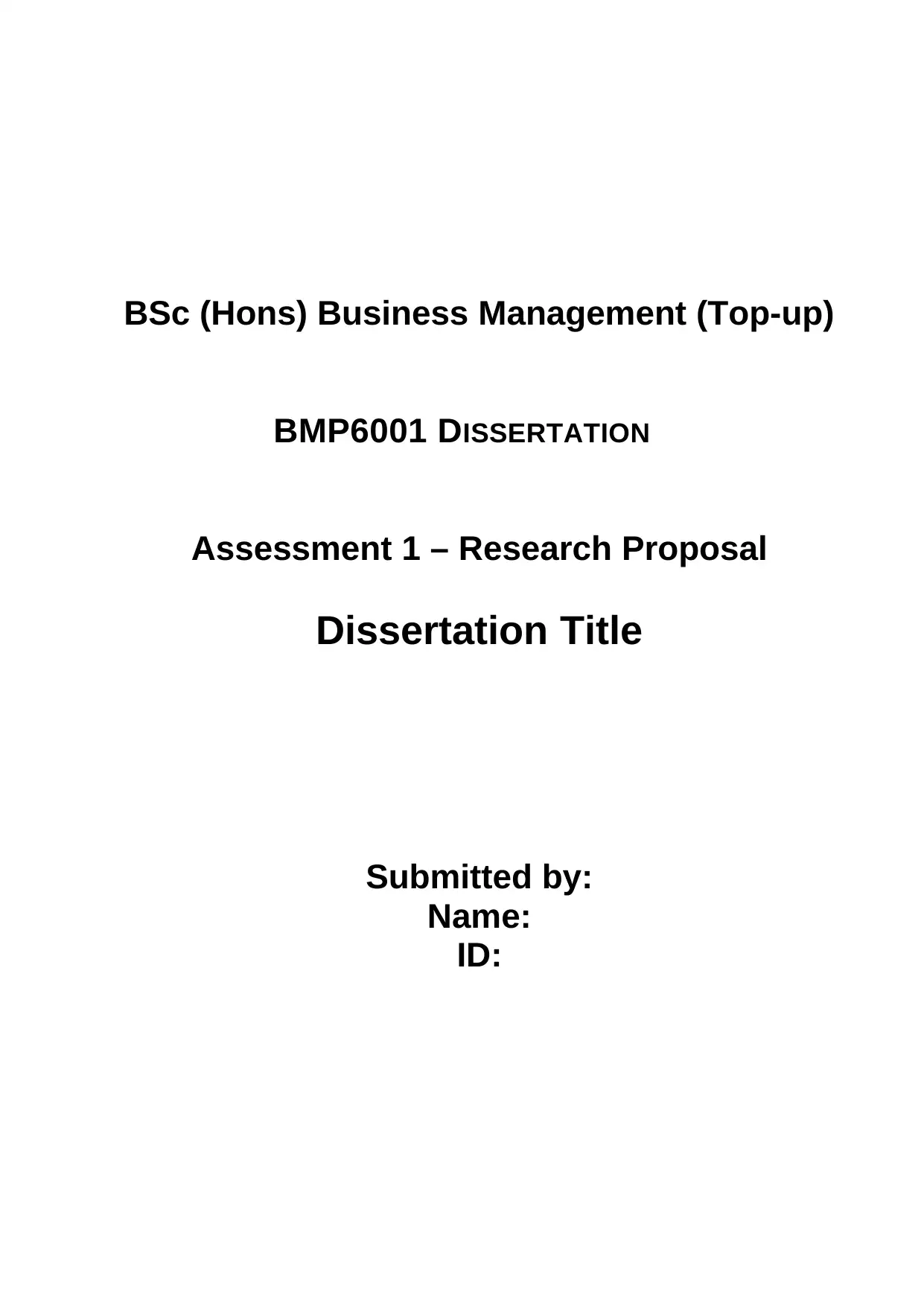
BSc (Hons) Business Management (Top-up)
BMP6001 DISSERTATION
Assessment 1 – Research Proposal
Dissertation Title
Submitted by:
Name:
ID:
BMP6001 DISSERTATION
Assessment 1 – Research Proposal
Dissertation Title
Submitted by:
Name:
ID:
Paraphrase This Document
Need a fresh take? Get an instant paraphrase of this document with our AI Paraphraser
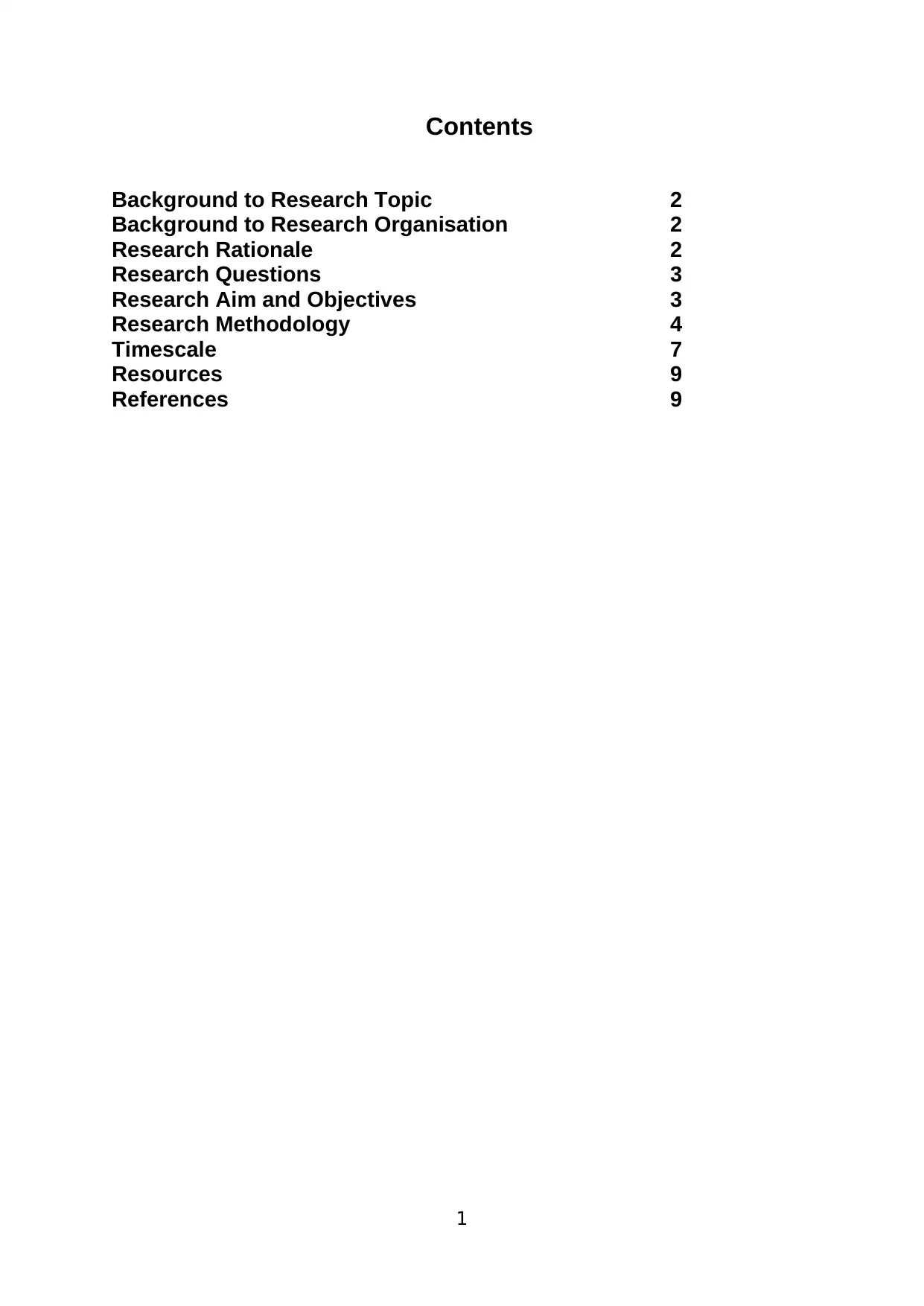
Contents
Background to Research Topic 2
Background to Research Organisation 2
Research Rationale 2
Research Questions 3
Research Aim and Objectives 3
Research Methodology 4
Timescale 7
Resources 9
References 9
1
Background to Research Topic 2
Background to Research Organisation 2
Research Rationale 2
Research Questions 3
Research Aim and Objectives 3
Research Methodology 4
Timescale 7
Resources 9
References 9
1
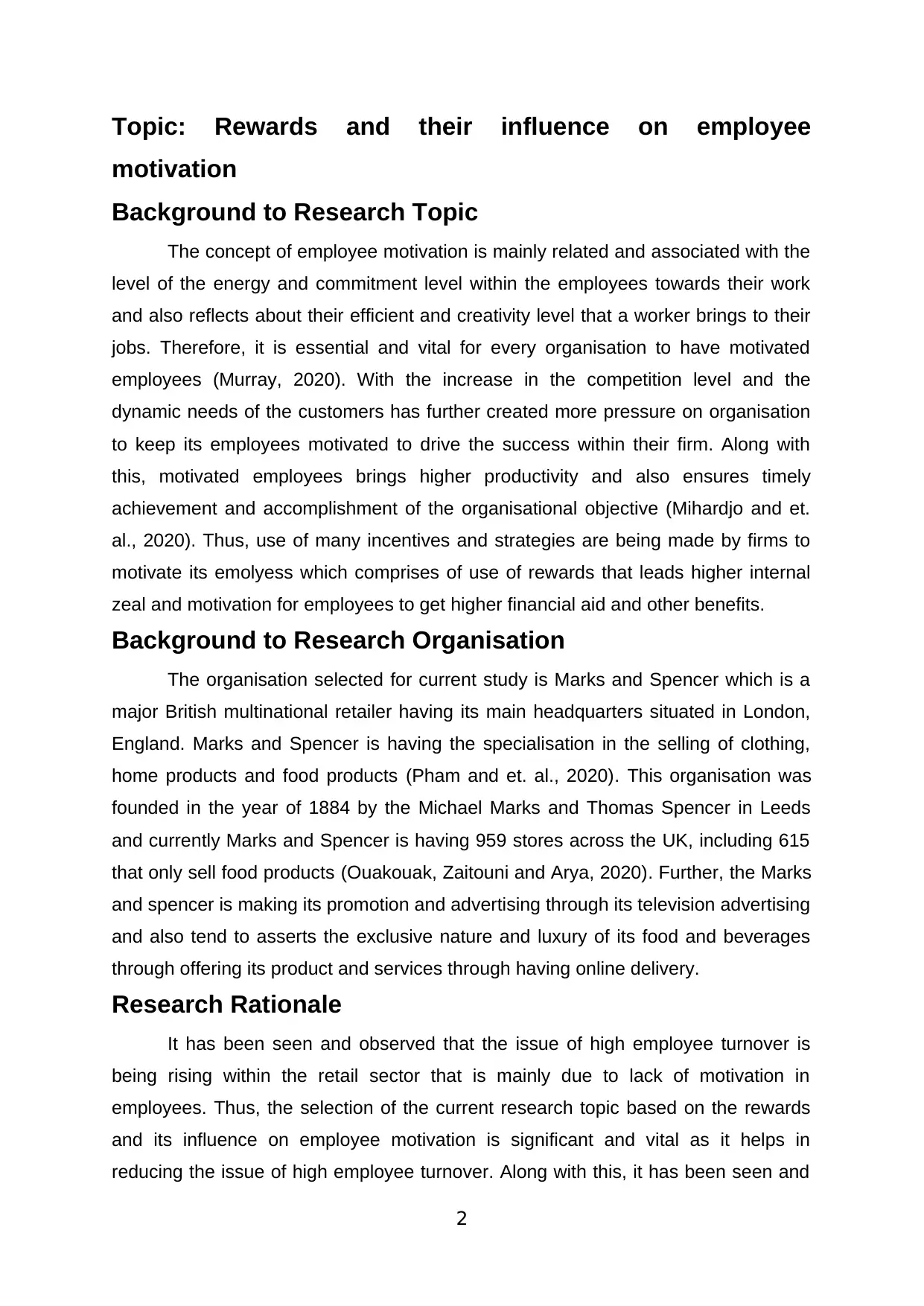
Topic: Rewards and their influence on employee
motivation
Background to Research Topic
The concept of employee motivation is mainly related and associated with the
level of the energy and commitment level within the employees towards their work
and also reflects about their efficient and creativity level that a worker brings to their
jobs. Therefore, it is essential and vital for every organisation to have motivated
employees (Murray, 2020). With the increase in the competition level and the
dynamic needs of the customers has further created more pressure on organisation
to keep its employees motivated to drive the success within their firm. Along with
this, motivated employees brings higher productivity and also ensures timely
achievement and accomplishment of the organisational objective (Mihardjo and et.
al., 2020). Thus, use of many incentives and strategies are being made by firms to
motivate its emolyess which comprises of use of rewards that leads higher internal
zeal and motivation for employees to get higher financial aid and other benefits.
Background to Research Organisation
The organisation selected for current study is Marks and Spencer which is a
major British multinational retailer having its main headquarters situated in London,
England. Marks and Spencer is having the specialisation in the selling of clothing,
home products and food products (Pham and et. al., 2020). This organisation was
founded in the year of 1884 by the Michael Marks and Thomas Spencer in Leeds
and currently Marks and Spencer is having 959 stores across the UK, including 615
that only sell food products (Ouakouak, Zaitouni and Arya, 2020). Further, the Marks
and spencer is making its promotion and advertising through its television advertising
and also tend to asserts the exclusive nature and luxury of its food and beverages
through offering its product and services through having online delivery.
Research Rationale
It has been seen and observed that the issue of high employee turnover is
being rising within the retail sector that is mainly due to lack of motivation in
employees. Thus, the selection of the current research topic based on the rewards
and its influence on employee motivation is significant and vital as it helps in
reducing the issue of high employee turnover. Along with this, it has been seen and
2
motivation
Background to Research Topic
The concept of employee motivation is mainly related and associated with the
level of the energy and commitment level within the employees towards their work
and also reflects about their efficient and creativity level that a worker brings to their
jobs. Therefore, it is essential and vital for every organisation to have motivated
employees (Murray, 2020). With the increase in the competition level and the
dynamic needs of the customers has further created more pressure on organisation
to keep its employees motivated to drive the success within their firm. Along with
this, motivated employees brings higher productivity and also ensures timely
achievement and accomplishment of the organisational objective (Mihardjo and et.
al., 2020). Thus, use of many incentives and strategies are being made by firms to
motivate its emolyess which comprises of use of rewards that leads higher internal
zeal and motivation for employees to get higher financial aid and other benefits.
Background to Research Organisation
The organisation selected for current study is Marks and Spencer which is a
major British multinational retailer having its main headquarters situated in London,
England. Marks and Spencer is having the specialisation in the selling of clothing,
home products and food products (Pham and et. al., 2020). This organisation was
founded in the year of 1884 by the Michael Marks and Thomas Spencer in Leeds
and currently Marks and Spencer is having 959 stores across the UK, including 615
that only sell food products (Ouakouak, Zaitouni and Arya, 2020). Further, the Marks
and spencer is making its promotion and advertising through its television advertising
and also tend to asserts the exclusive nature and luxury of its food and beverages
through offering its product and services through having online delivery.
Research Rationale
It has been seen and observed that the issue of high employee turnover is
being rising within the retail sector that is mainly due to lack of motivation in
employees. Thus, the selection of the current research topic based on the rewards
and its influence on employee motivation is significant and vital as it helps in
reducing the issue of high employee turnover. Along with this, it has been seen and
2
⊘ This is a preview!⊘
Do you want full access?
Subscribe today to unlock all pages.

Trusted by 1+ million students worldwide
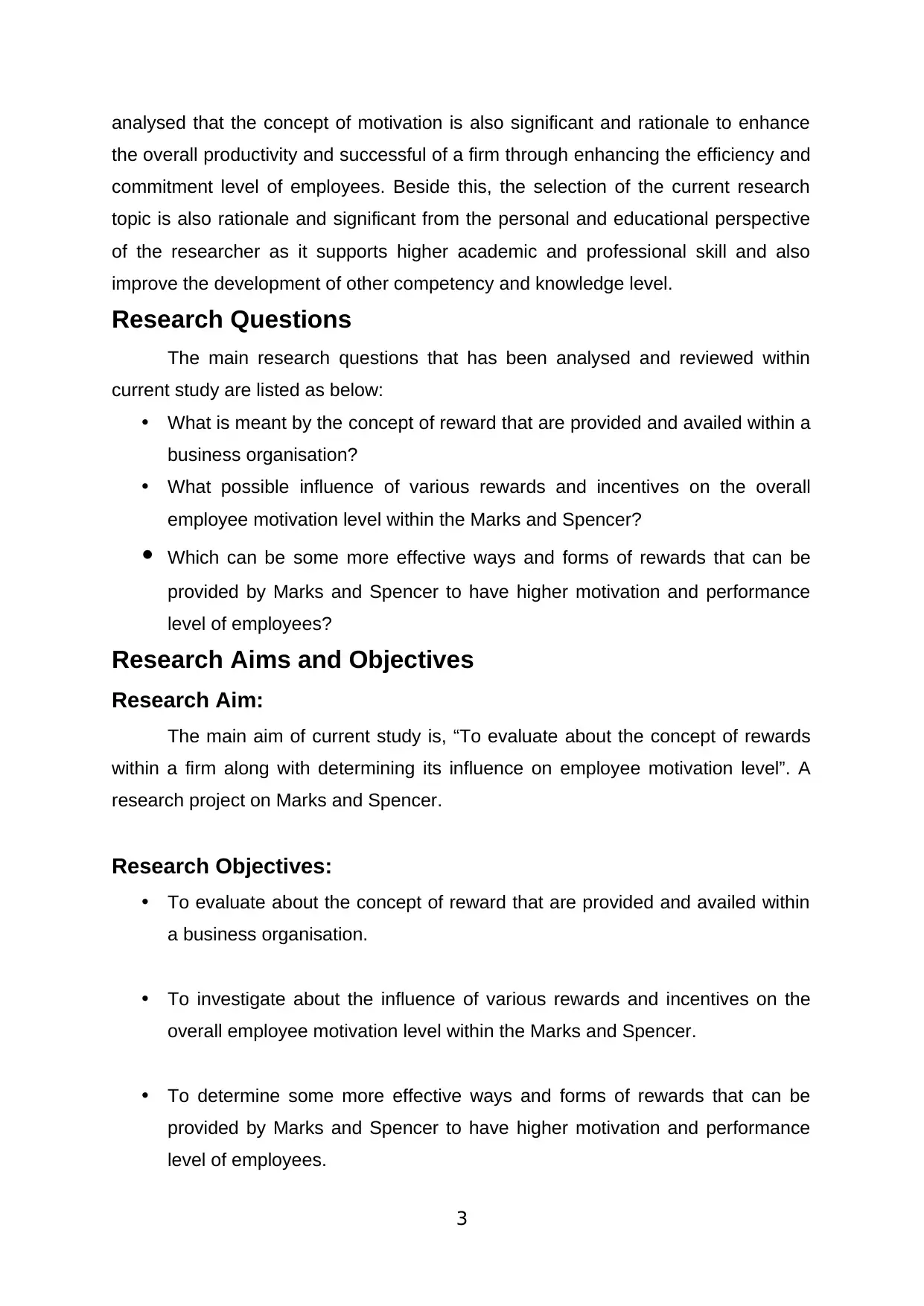
analysed that the concept of motivation is also significant and rationale to enhance
the overall productivity and successful of a firm through enhancing the efficiency and
commitment level of employees. Beside this, the selection of the current research
topic is also rationale and significant from the personal and educational perspective
of the researcher as it supports higher academic and professional skill and also
improve the development of other competency and knowledge level.
Research Questions
The main research questions that has been analysed and reviewed within
current study are listed as below:
• What is meant by the concept of reward that are provided and availed within a
business organisation?
• What possible influence of various rewards and incentives on the overall
employee motivation level within the Marks and Spencer?
• Which can be some more effective ways and forms of rewards that can be
provided by Marks and Spencer to have higher motivation and performance
level of employees?
Research Aims and Objectives
Research Aim:
The main aim of current study is, “To evaluate about the concept of rewards
within a firm along with determining its influence on employee motivation level”. A
research project on Marks and Spencer.
Research Objectives:
• To evaluate about the concept of reward that are provided and availed within
a business organisation.
• To investigate about the influence of various rewards and incentives on the
overall employee motivation level within the Marks and Spencer.
• To determine some more effective ways and forms of rewards that can be
provided by Marks and Spencer to have higher motivation and performance
level of employees.
3
the overall productivity and successful of a firm through enhancing the efficiency and
commitment level of employees. Beside this, the selection of the current research
topic is also rationale and significant from the personal and educational perspective
of the researcher as it supports higher academic and professional skill and also
improve the development of other competency and knowledge level.
Research Questions
The main research questions that has been analysed and reviewed within
current study are listed as below:
• What is meant by the concept of reward that are provided and availed within a
business organisation?
• What possible influence of various rewards and incentives on the overall
employee motivation level within the Marks and Spencer?
• Which can be some more effective ways and forms of rewards that can be
provided by Marks and Spencer to have higher motivation and performance
level of employees?
Research Aims and Objectives
Research Aim:
The main aim of current study is, “To evaluate about the concept of rewards
within a firm along with determining its influence on employee motivation level”. A
research project on Marks and Spencer.
Research Objectives:
• To evaluate about the concept of reward that are provided and availed within
a business organisation.
• To investigate about the influence of various rewards and incentives on the
overall employee motivation level within the Marks and Spencer.
• To determine some more effective ways and forms of rewards that can be
provided by Marks and Spencer to have higher motivation and performance
level of employees.
3
Paraphrase This Document
Need a fresh take? Get an instant paraphrase of this document with our AI Paraphraser
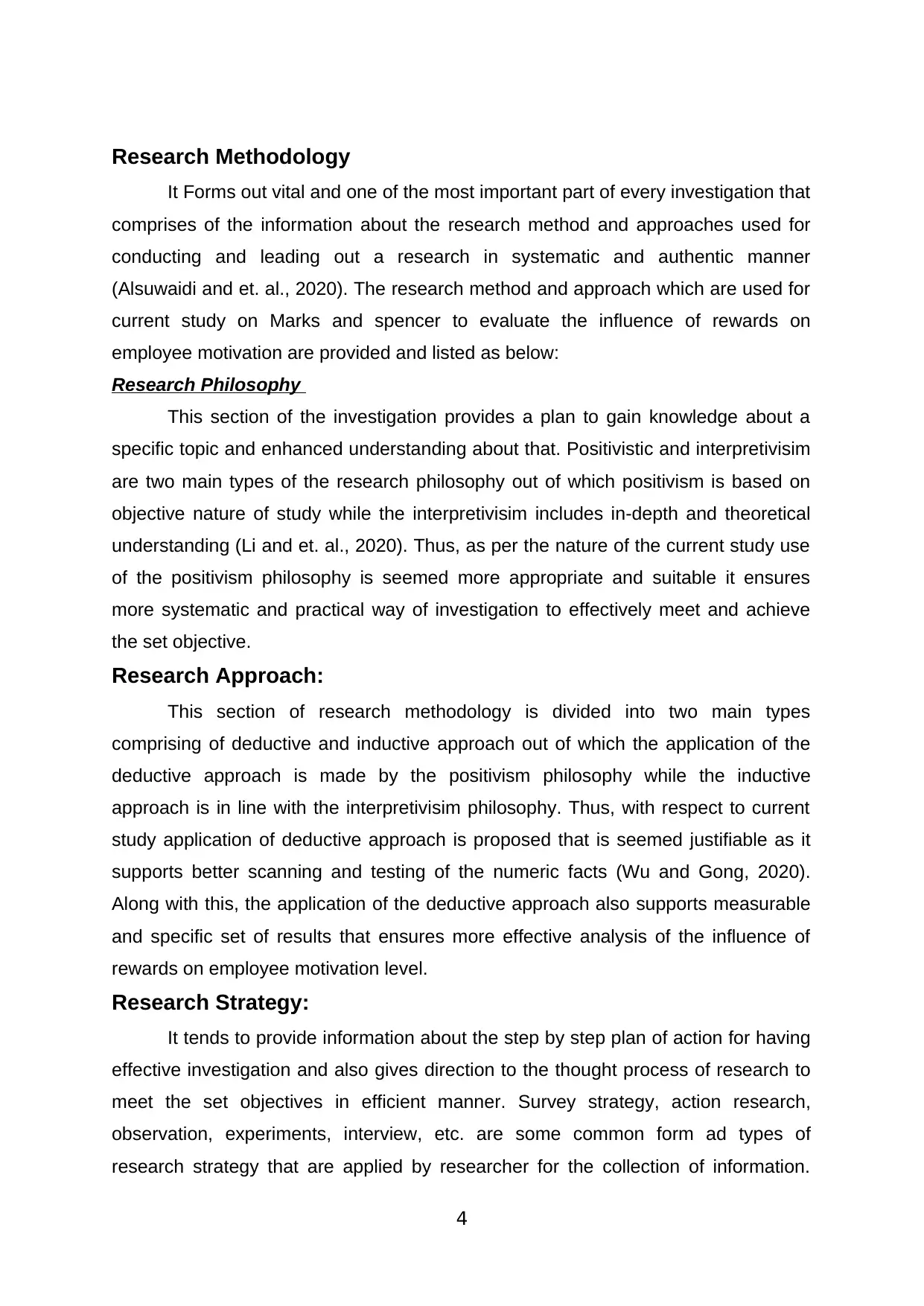
Research Methodology
It Forms out vital and one of the most important part of every investigation that
comprises of the information about the research method and approaches used for
conducting and leading out a research in systematic and authentic manner
(Alsuwaidi and et. al., 2020). The research method and approach which are used for
current study on Marks and spencer to evaluate the influence of rewards on
employee motivation are provided and listed as below:
Research Philosophy
This section of the investigation provides a plan to gain knowledge about a
specific topic and enhanced understanding about that. Positivistic and interpretivisim
are two main types of the research philosophy out of which positivism is based on
objective nature of study while the interpretivisim includes in-depth and theoretical
understanding (Li and et. al., 2020). Thus, as per the nature of the current study use
of the positivism philosophy is seemed more appropriate and suitable it ensures
more systematic and practical way of investigation to effectively meet and achieve
the set objective.
Research Approach:
This section of research methodology is divided into two main types
comprising of deductive and inductive approach out of which the application of the
deductive approach is made by the positivism philosophy while the inductive
approach is in line with the interpretivisim philosophy. Thus, with respect to current
study application of deductive approach is proposed that is seemed justifiable as it
supports better scanning and testing of the numeric facts (Wu and Gong, 2020).
Along with this, the application of the deductive approach also supports measurable
and specific set of results that ensures more effective analysis of the influence of
rewards on employee motivation level.
Research Strategy:
It tends to provide information about the step by step plan of action for having
effective investigation and also gives direction to the thought process of research to
meet the set objectives in efficient manner. Survey strategy, action research,
observation, experiments, interview, etc. are some common form ad types of
research strategy that are applied by researcher for the collection of information.
4
It Forms out vital and one of the most important part of every investigation that
comprises of the information about the research method and approaches used for
conducting and leading out a research in systematic and authentic manner
(Alsuwaidi and et. al., 2020). The research method and approach which are used for
current study on Marks and spencer to evaluate the influence of rewards on
employee motivation are provided and listed as below:
Research Philosophy
This section of the investigation provides a plan to gain knowledge about a
specific topic and enhanced understanding about that. Positivistic and interpretivisim
are two main types of the research philosophy out of which positivism is based on
objective nature of study while the interpretivisim includes in-depth and theoretical
understanding (Li and et. al., 2020). Thus, as per the nature of the current study use
of the positivism philosophy is seemed more appropriate and suitable it ensures
more systematic and practical way of investigation to effectively meet and achieve
the set objective.
Research Approach:
This section of research methodology is divided into two main types
comprising of deductive and inductive approach out of which the application of the
deductive approach is made by the positivism philosophy while the inductive
approach is in line with the interpretivisim philosophy. Thus, with respect to current
study application of deductive approach is proposed that is seemed justifiable as it
supports better scanning and testing of the numeric facts (Wu and Gong, 2020).
Along with this, the application of the deductive approach also supports measurable
and specific set of results that ensures more effective analysis of the influence of
rewards on employee motivation level.
Research Strategy:
It tends to provide information about the step by step plan of action for having
effective investigation and also gives direction to the thought process of research to
meet the set objectives in efficient manner. Survey strategy, action research,
observation, experiments, interview, etc. are some common form ad types of
research strategy that are applied by researcher for the collection of information.
4
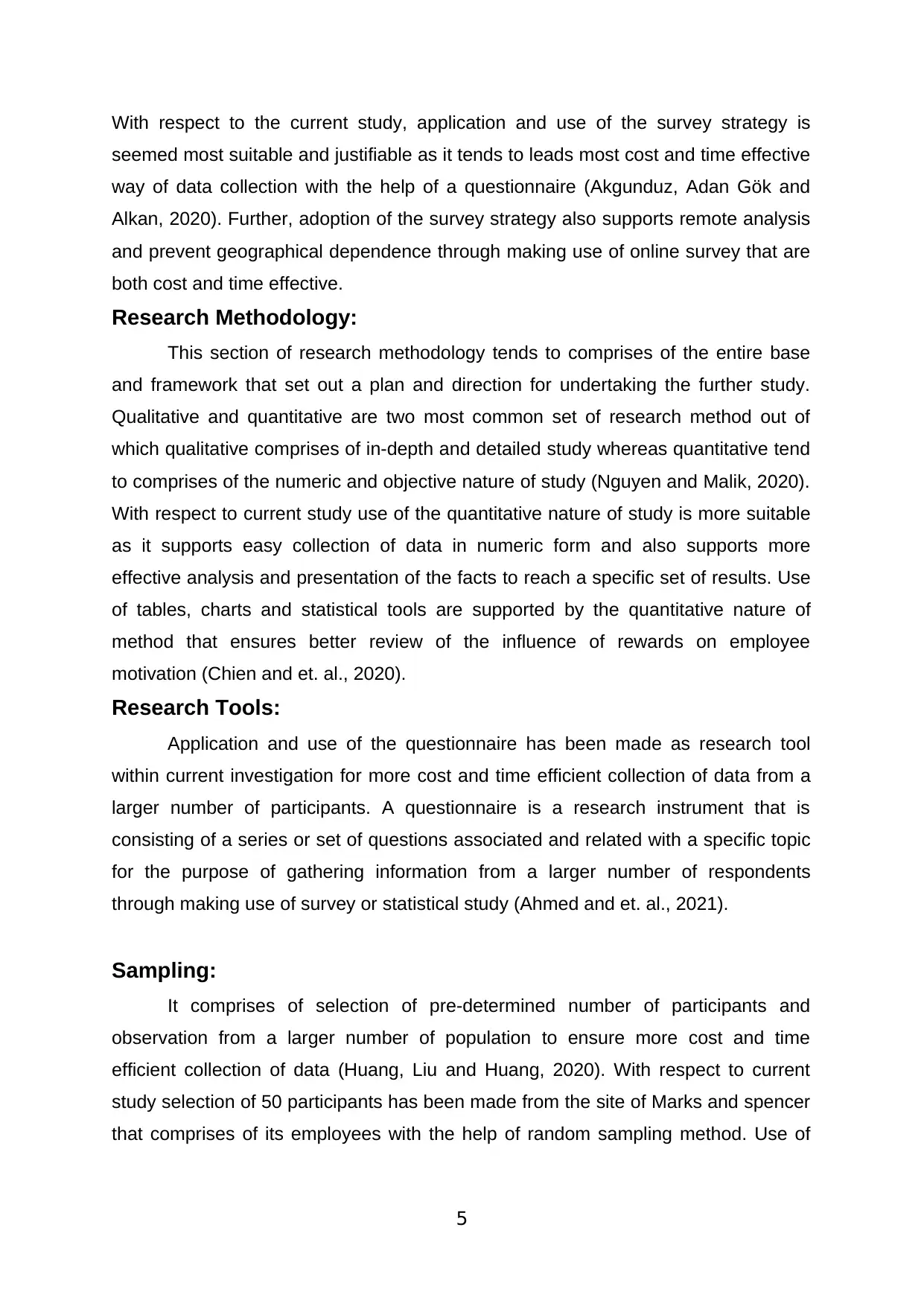
With respect to the current study, application and use of the survey strategy is
seemed most suitable and justifiable as it tends to leads most cost and time effective
way of data collection with the help of a questionnaire (Akgunduz, Adan Gök and
Alkan, 2020). Further, adoption of the survey strategy also supports remote analysis
and prevent geographical dependence through making use of online survey that are
both cost and time effective.
Research Methodology:
This section of research methodology tends to comprises of the entire base
and framework that set out a plan and direction for undertaking the further study.
Qualitative and quantitative are two most common set of research method out of
which qualitative comprises of in-depth and detailed study whereas quantitative tend
to comprises of the numeric and objective nature of study (Nguyen and Malik, 2020).
With respect to current study use of the quantitative nature of study is more suitable
as it supports easy collection of data in numeric form and also supports more
effective analysis and presentation of the facts to reach a specific set of results. Use
of tables, charts and statistical tools are supported by the quantitative nature of
method that ensures better review of the influence of rewards on employee
motivation (Chien and et. al., 2020).
Research Tools:
Application and use of the questionnaire has been made as research tool
within current investigation for more cost and time efficient collection of data from a
larger number of participants. A questionnaire is a research instrument that is
consisting of a series or set of questions associated and related with a specific topic
for the purpose of gathering information from a larger number of respondents
through making use of survey or statistical study (Ahmed and et. al., 2021).
Sampling:
It comprises of selection of pre-determined number of participants and
observation from a larger number of population to ensure more cost and time
efficient collection of data (Huang, Liu and Huang, 2020). With respect to current
study selection of 50 participants has been made from the site of Marks and spencer
that comprises of its employees with the help of random sampling method. Use of
5
seemed most suitable and justifiable as it tends to leads most cost and time effective
way of data collection with the help of a questionnaire (Akgunduz, Adan Gök and
Alkan, 2020). Further, adoption of the survey strategy also supports remote analysis
and prevent geographical dependence through making use of online survey that are
both cost and time effective.
Research Methodology:
This section of research methodology tends to comprises of the entire base
and framework that set out a plan and direction for undertaking the further study.
Qualitative and quantitative are two most common set of research method out of
which qualitative comprises of in-depth and detailed study whereas quantitative tend
to comprises of the numeric and objective nature of study (Nguyen and Malik, 2020).
With respect to current study use of the quantitative nature of study is more suitable
as it supports easy collection of data in numeric form and also supports more
effective analysis and presentation of the facts to reach a specific set of results. Use
of tables, charts and statistical tools are supported by the quantitative nature of
method that ensures better review of the influence of rewards on employee
motivation (Chien and et. al., 2020).
Research Tools:
Application and use of the questionnaire has been made as research tool
within current investigation for more cost and time efficient collection of data from a
larger number of participants. A questionnaire is a research instrument that is
consisting of a series or set of questions associated and related with a specific topic
for the purpose of gathering information from a larger number of respondents
through making use of survey or statistical study (Ahmed and et. al., 2021).
Sampling:
It comprises of selection of pre-determined number of participants and
observation from a larger number of population to ensure more cost and time
efficient collection of data (Huang, Liu and Huang, 2020). With respect to current
study selection of 50 participants has been made from the site of Marks and spencer
that comprises of its employees with the help of random sampling method. Use of
5
⊘ This is a preview!⊘
Do you want full access?
Subscribe today to unlock all pages.

Trusted by 1+ million students worldwide
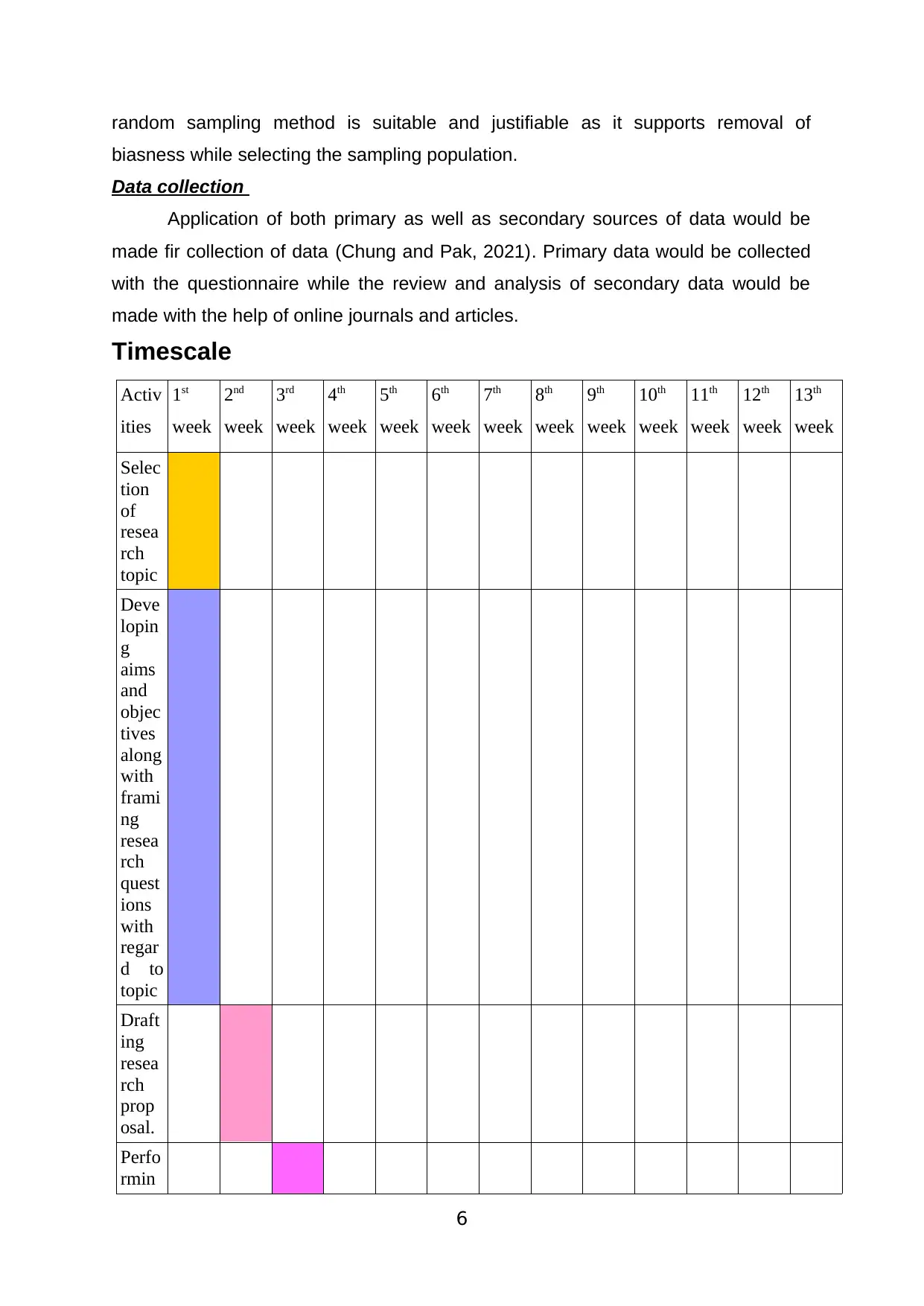
random sampling method is suitable and justifiable as it supports removal of
biasness while selecting the sampling population.
Data collection
Application of both primary as well as secondary sources of data would be
made fir collection of data (Chung and Pak, 2021). Primary data would be collected
with the questionnaire while the review and analysis of secondary data would be
made with the help of online journals and articles.
Timescale
Activ
ities
1st
week
2nd
week
3rd
week
4th
week
5th
week
6th
week
7th
week
8th
week
9th
week
10th
week
11th
week
12th
week
13th
week
Selec
tion
of
resea
rch
topic
Deve
lopin
g
aims
and
objec
tives
along
with
frami
ng
resea
rch
quest
ions
with
regar
d to
topic
Draft
ing
resea
rch
prop
osal.
Perfo
rmin
6
biasness while selecting the sampling population.
Data collection
Application of both primary as well as secondary sources of data would be
made fir collection of data (Chung and Pak, 2021). Primary data would be collected
with the questionnaire while the review and analysis of secondary data would be
made with the help of online journals and articles.
Timescale
Activ
ities
1st
week
2nd
week
3rd
week
4th
week
5th
week
6th
week
7th
week
8th
week
9th
week
10th
week
11th
week
12th
week
13th
week
Selec
tion
of
resea
rch
topic
Deve
lopin
g
aims
and
objec
tives
along
with
frami
ng
resea
rch
quest
ions
with
regar
d to
topic
Draft
ing
resea
rch
prop
osal.
Perfo
rmin
6
Paraphrase This Document
Need a fresh take? Get an instant paraphrase of this document with our AI Paraphraser
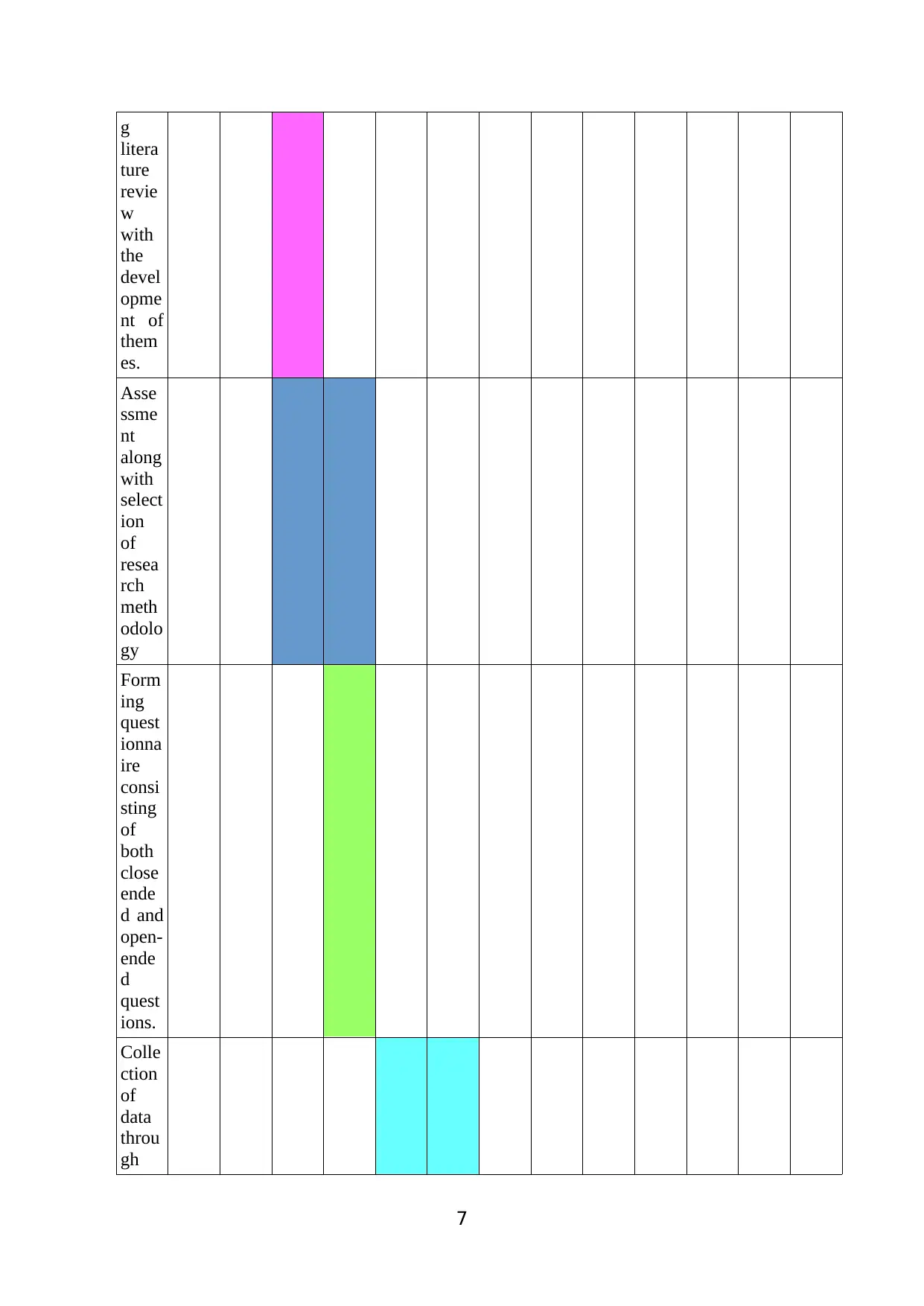
g
litera
ture
revie
w
with
the
devel
opme
nt of
them
es.
Asse
ssme
nt
along
with
select
ion
of
resea
rch
meth
odolo
gy
Form
ing
quest
ionna
ire
consi
sting
of
both
close
ende
d and
open-
ende
d
quest
ions.
Colle
ction
of
data
throu
gh
7
litera
ture
revie
w
with
the
devel
opme
nt of
them
es.
Asse
ssme
nt
along
with
select
ion
of
resea
rch
meth
odolo
gy
Form
ing
quest
ionna
ire
consi
sting
of
both
close
ende
d and
open-
ende
d
quest
ions.
Colle
ction
of
data
throu
gh
7
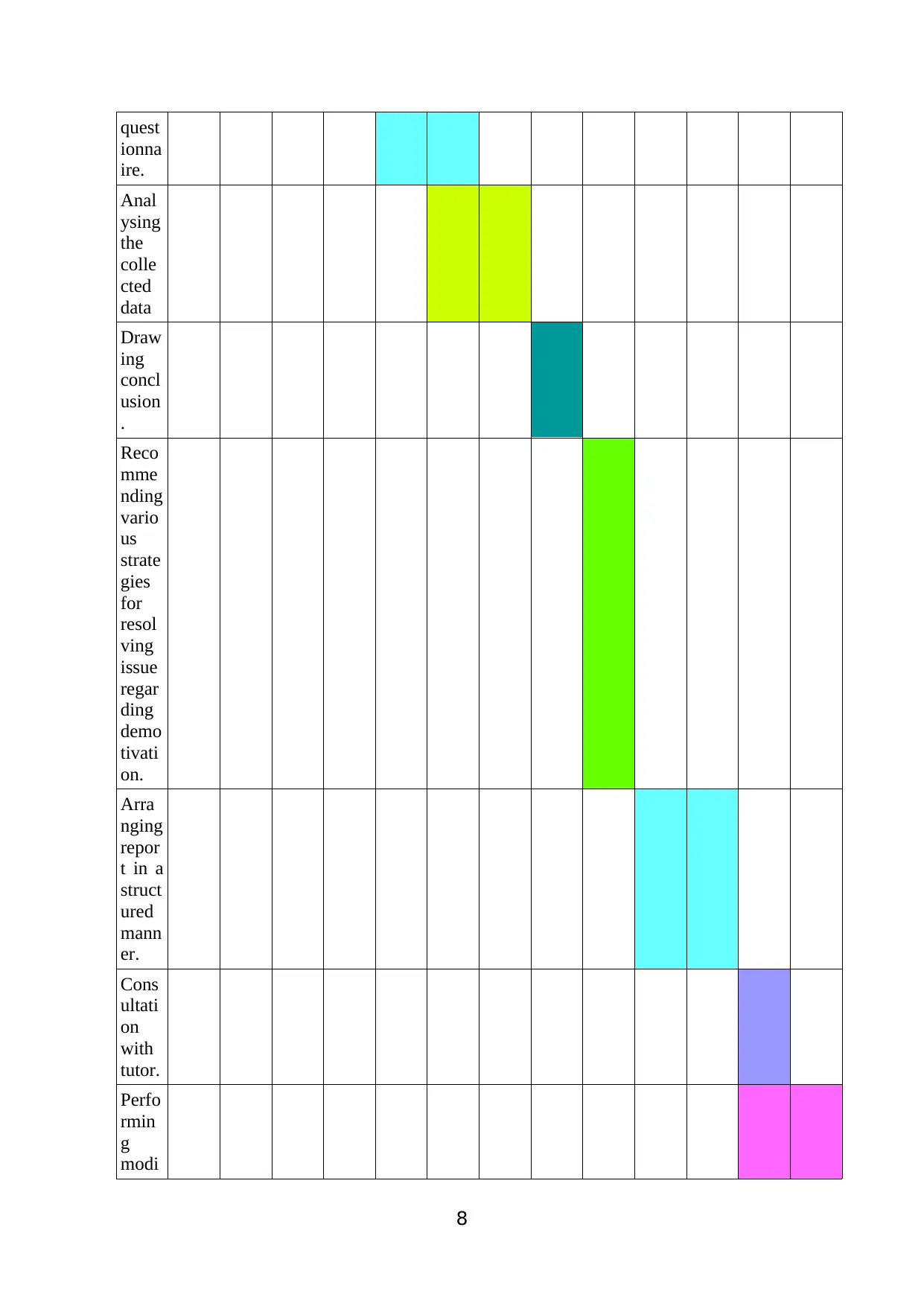
quest
ionna
ire.
Anal
ysing
the
colle
cted
data
Draw
ing
concl
usion
.
Reco
mme
nding
vario
us
strate
gies
for
resol
ving
issue
regar
ding
demo
tivati
on.
Arra
nging
repor
t in a
struct
ured
mann
er.
Cons
ultati
on
with
tutor.
Perfo
rmin
g
modi
8
ionna
ire.
Anal
ysing
the
colle
cted
data
Draw
ing
concl
usion
.
Reco
mme
nding
vario
us
strate
gies
for
resol
ving
issue
regar
ding
demo
tivati
on.
Arra
nging
repor
t in a
struct
ured
mann
er.
Cons
ultati
on
with
tutor.
Perfo
rmin
g
modi
8
⊘ This is a preview!⊘
Do you want full access?
Subscribe today to unlock all pages.

Trusted by 1+ million students worldwide
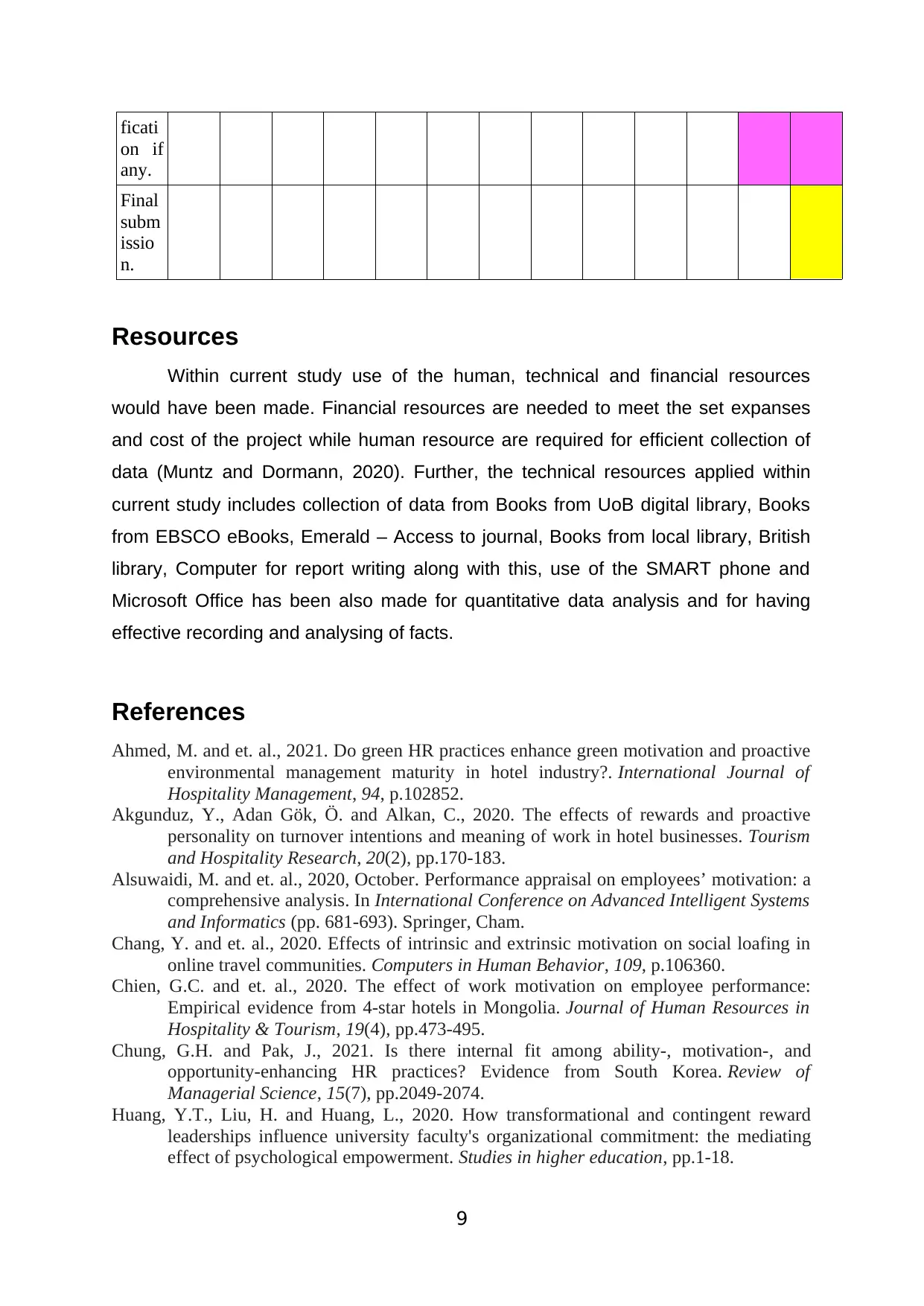
ficati
on if
any.
Final
subm
issio
n.
Resources
Within current study use of the human, technical and financial resources
would have been made. Financial resources are needed to meet the set expanses
and cost of the project while human resource are required for efficient collection of
data (Muntz and Dormann, 2020). Further, the technical resources applied within
current study includes collection of data from Books from UoB digital library, Books
from EBSCO eBooks, Emerald – Access to journal, Books from local library, British
library, Computer for report writing along with this, use of the SMART phone and
Microsoft Office has been also made for quantitative data analysis and for having
effective recording and analysing of facts.
References
Ahmed, M. and et. al., 2021. Do green HR practices enhance green motivation and proactive
environmental management maturity in hotel industry?. International Journal of
Hospitality Management, 94, p.102852.
Akgunduz, Y., Adan Gök, Ö. and Alkan, C., 2020. The effects of rewards and proactive
personality on turnover intentions and meaning of work in hotel businesses. Tourism
and Hospitality Research, 20(2), pp.170-183.
Alsuwaidi, M. and et. al., 2020, October. Performance appraisal on employees’ motivation: a
comprehensive analysis. In International Conference on Advanced Intelligent Systems
and Informatics (pp. 681-693). Springer, Cham.
Chang, Y. and et. al., 2020. Effects of intrinsic and extrinsic motivation on social loafing in
online travel communities. Computers in Human Behavior, 109, p.106360.
Chien, G.C. and et. al., 2020. The effect of work motivation on employee performance:
Empirical evidence from 4-star hotels in Mongolia. Journal of Human Resources in
Hospitality & Tourism, 19(4), pp.473-495.
Chung, G.H. and Pak, J., 2021. Is there internal fit among ability-, motivation-, and
opportunity-enhancing HR practices? Evidence from South Korea. Review of
Managerial Science, 15(7), pp.2049-2074.
Huang, Y.T., Liu, H. and Huang, L., 2020. How transformational and contingent reward
leaderships influence university faculty's organizational commitment: the mediating
effect of psychological empowerment. Studies in higher education, pp.1-18.
9
on if
any.
Final
subm
issio
n.
Resources
Within current study use of the human, technical and financial resources
would have been made. Financial resources are needed to meet the set expanses
and cost of the project while human resource are required for efficient collection of
data (Muntz and Dormann, 2020). Further, the technical resources applied within
current study includes collection of data from Books from UoB digital library, Books
from EBSCO eBooks, Emerald – Access to journal, Books from local library, British
library, Computer for report writing along with this, use of the SMART phone and
Microsoft Office has been also made for quantitative data analysis and for having
effective recording and analysing of facts.
References
Ahmed, M. and et. al., 2021. Do green HR practices enhance green motivation and proactive
environmental management maturity in hotel industry?. International Journal of
Hospitality Management, 94, p.102852.
Akgunduz, Y., Adan Gök, Ö. and Alkan, C., 2020. The effects of rewards and proactive
personality on turnover intentions and meaning of work in hotel businesses. Tourism
and Hospitality Research, 20(2), pp.170-183.
Alsuwaidi, M. and et. al., 2020, October. Performance appraisal on employees’ motivation: a
comprehensive analysis. In International Conference on Advanced Intelligent Systems
and Informatics (pp. 681-693). Springer, Cham.
Chang, Y. and et. al., 2020. Effects of intrinsic and extrinsic motivation on social loafing in
online travel communities. Computers in Human Behavior, 109, p.106360.
Chien, G.C. and et. al., 2020. The effect of work motivation on employee performance:
Empirical evidence from 4-star hotels in Mongolia. Journal of Human Resources in
Hospitality & Tourism, 19(4), pp.473-495.
Chung, G.H. and Pak, J., 2021. Is there internal fit among ability-, motivation-, and
opportunity-enhancing HR practices? Evidence from South Korea. Review of
Managerial Science, 15(7), pp.2049-2074.
Huang, Y.T., Liu, H. and Huang, L., 2020. How transformational and contingent reward
leaderships influence university faculty's organizational commitment: the mediating
effect of psychological empowerment. Studies in higher education, pp.1-18.
9
Paraphrase This Document
Need a fresh take? Get an instant paraphrase of this document with our AI Paraphraser
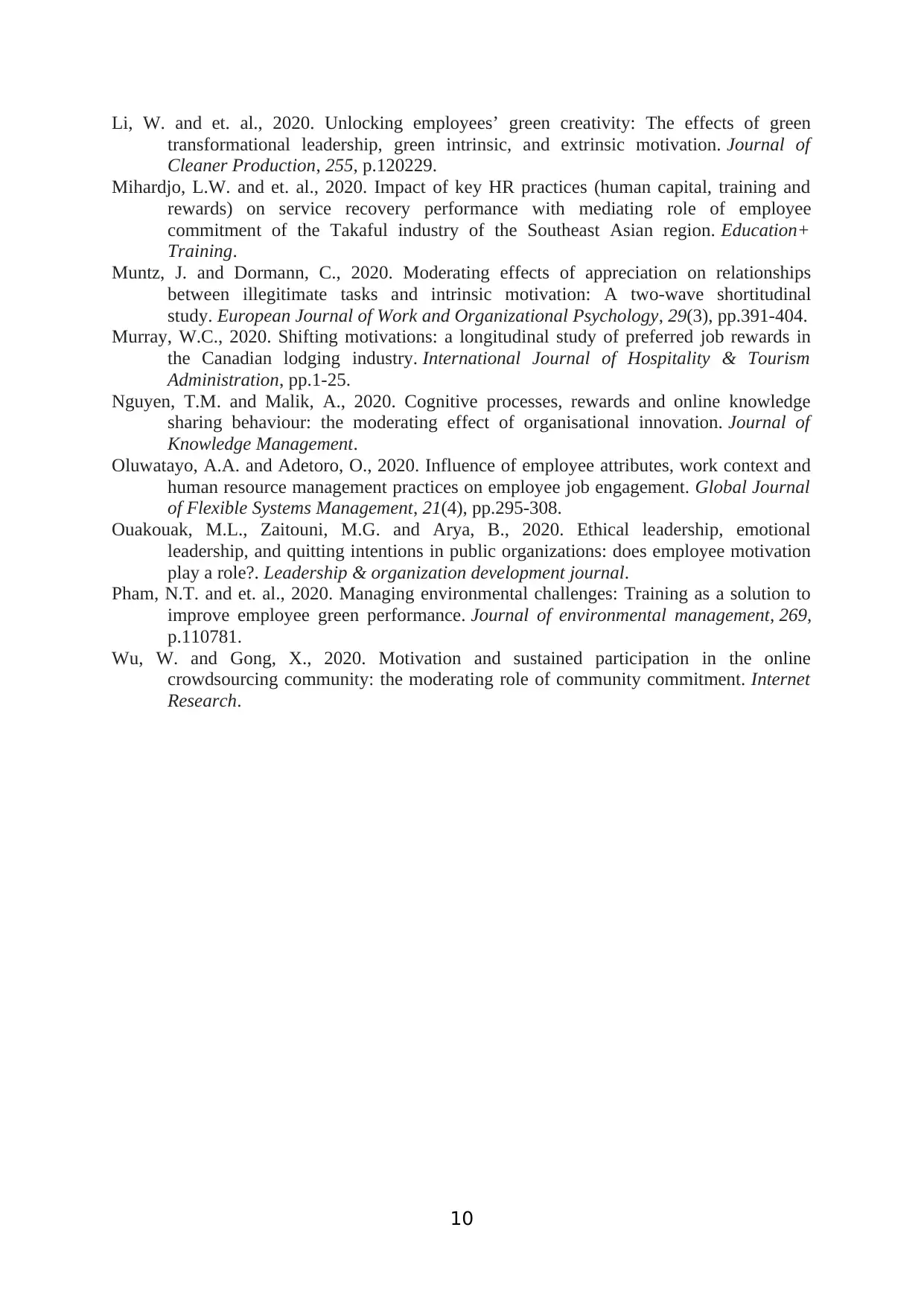
Li, W. and et. al., 2020. Unlocking employees’ green creativity: The effects of green
transformational leadership, green intrinsic, and extrinsic motivation. Journal of
Cleaner Production, 255, p.120229.
Mihardjo, L.W. and et. al., 2020. Impact of key HR practices (human capital, training and
rewards) on service recovery performance with mediating role of employee
commitment of the Takaful industry of the Southeast Asian region. Education+
Training.
Muntz, J. and Dormann, C., 2020. Moderating effects of appreciation on relationships
between illegitimate tasks and intrinsic motivation: A two-wave shortitudinal
study. European Journal of Work and Organizational Psychology, 29(3), pp.391-404.
Murray, W.C., 2020. Shifting motivations: a longitudinal study of preferred job rewards in
the Canadian lodging industry. International Journal of Hospitality & Tourism
Administration, pp.1-25.
Nguyen, T.M. and Malik, A., 2020. Cognitive processes, rewards and online knowledge
sharing behaviour: the moderating effect of organisational innovation. Journal of
Knowledge Management.
Oluwatayo, A.A. and Adetoro, O., 2020. Influence of employee attributes, work context and
human resource management practices on employee job engagement. Global Journal
of Flexible Systems Management, 21(4), pp.295-308.
Ouakouak, M.L., Zaitouni, M.G. and Arya, B., 2020. Ethical leadership, emotional
leadership, and quitting intentions in public organizations: does employee motivation
play a role?. Leadership & organization development journal.
Pham, N.T. and et. al., 2020. Managing environmental challenges: Training as a solution to
improve employee green performance. Journal of environmental management, 269,
p.110781.
Wu, W. and Gong, X., 2020. Motivation and sustained participation in the online
crowdsourcing community: the moderating role of community commitment. Internet
Research.
10
transformational leadership, green intrinsic, and extrinsic motivation. Journal of
Cleaner Production, 255, p.120229.
Mihardjo, L.W. and et. al., 2020. Impact of key HR practices (human capital, training and
rewards) on service recovery performance with mediating role of employee
commitment of the Takaful industry of the Southeast Asian region. Education+
Training.
Muntz, J. and Dormann, C., 2020. Moderating effects of appreciation on relationships
between illegitimate tasks and intrinsic motivation: A two-wave shortitudinal
study. European Journal of Work and Organizational Psychology, 29(3), pp.391-404.
Murray, W.C., 2020. Shifting motivations: a longitudinal study of preferred job rewards in
the Canadian lodging industry. International Journal of Hospitality & Tourism
Administration, pp.1-25.
Nguyen, T.M. and Malik, A., 2020. Cognitive processes, rewards and online knowledge
sharing behaviour: the moderating effect of organisational innovation. Journal of
Knowledge Management.
Oluwatayo, A.A. and Adetoro, O., 2020. Influence of employee attributes, work context and
human resource management practices on employee job engagement. Global Journal
of Flexible Systems Management, 21(4), pp.295-308.
Ouakouak, M.L., Zaitouni, M.G. and Arya, B., 2020. Ethical leadership, emotional
leadership, and quitting intentions in public organizations: does employee motivation
play a role?. Leadership & organization development journal.
Pham, N.T. and et. al., 2020. Managing environmental challenges: Training as a solution to
improve employee green performance. Journal of environmental management, 269,
p.110781.
Wu, W. and Gong, X., 2020. Motivation and sustained participation in the online
crowdsourcing community: the moderating role of community commitment. Internet
Research.
10
1 out of 11
Related Documents
Your All-in-One AI-Powered Toolkit for Academic Success.
+13062052269
info@desklib.com
Available 24*7 on WhatsApp / Email
![[object Object]](/_next/static/media/star-bottom.7253800d.svg)
Unlock your academic potential
Copyright © 2020–2025 A2Z Services. All Rights Reserved. Developed and managed by ZUCOL.





